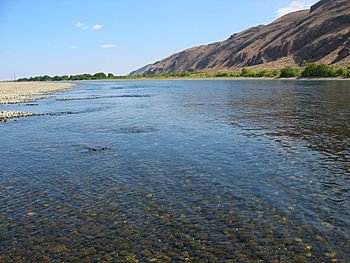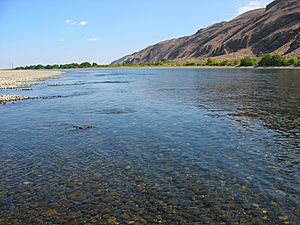Hanford Reach facts for kids
Quick facts for kids Hanford Reach |
|
|---|---|

A section of the Hanford Reach
|
|
| Country | United States |
| State | Washington |
| Physical characteristics | |
| Main source | Base of Priest Rapids Dam Near Desert Aire 443 ft (135 m) 46°38′35″N 119°54′39″W / 46.64306°N 119.91083°W |
| River mouth | Lake Wallula Richland 340 ft (100 m) 46°16′46″N 119°16′03″W / 46.27944°N 119.26750°W |
| Length | 45 mi (72 km) |
| Basin features | |
| River system | the Columbia River |
| Basin size | 96,000 sq mi (250,000 km2) |
The Hanford Reach is a special part of the Columbia River in eastern Washington state. It is about 51 kilometers (32 miles) long. This section of the river is unique because it flows freely, unlike many other parts of the Columbia River that are held back by dams.
The Hanford Reach gets its name from a big bend in the river. The river usually flows south, but here it turns north for a while. This area is very important for nature and history.
About the Hanford Reach
The Hanford Reach is the only part of the Columbia River in the United States that is not affected by ocean tides or held in a reservoir. A reservoir is like a big lake created by a dam. There's only one other short section like this, far north near the Canadian border.
Why is it Special?
Most of the Hanford Reach flows through a place called the Hanford Site. This site was very important during World War II. It was used to produce materials for national defense. Today, much of this area is protected as the Hanford Reach National Monument. This monument helps keep the natural environment safe.
The river section starts below the Priest Rapids Dam. It ends before the McNary Dam. These dams control the river's flow for different purposes. The McNary Dam also holds back the water from the Snake River, which is the biggest river that flows into the Columbia.
Animals and Plants
The Hanford Reach is home to many different kinds of fish. Over forty species of fish live here. It is especially important for chinook salmon. Many fall chinook salmon come here to lay their eggs. This process is called spawning.
The river also has parts with fast-moving water called rapids. One of these is called Coyote Rapids. These rapids add to the natural beauty and challenge of the river.


